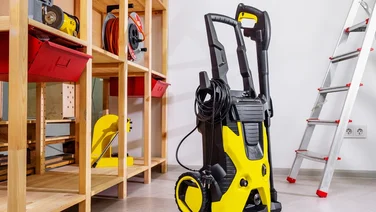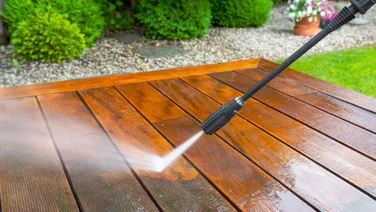To help us provide you with free impartial advice, we may earn a commission if you buy through links on our site. Learn more

When it comes to outdoor spring cleaning and summer spruce-ups, your patio and decking are among the top spaces that will be in need of a refresh, as they can easily develop mould, moss and other grime. Having tested and reviewed dozens of models, we can say without a doubt that pressure washers are an excellent cleaning appliance for sprucing up outdoor surfaces like your patio, decking or driveway. However, as noted in our guide to things you shouldn’t pressure wash, due to the delicate nature of certain types of wood, stone or paint, the strong jet stream of a pressure washer may not always be the right way to go.
If you think your decking or patio would benefit from a more delicate approach, or if you simply don’t own a pressure washer, follow our guide below. Our guide features step-by-step instructions for cleaning your decking and patio without a pressure washer, as well as tips and advice from Georgina Shepherd, cleaning expert at Housekeep.
Why should you avoid using a pressure washer on your decking or patio?
While pressure washers are probably the first thing that comes to mind when we think about cleaning outdoor surfaces like your decking or patio, they can also potentially damage these surfaces. Using too high a pressure can damage your wood and stone, according to Georgina, who says that while “pressure washers can definitely be effective for removing grime, it’s important to use them carefully. Too much pressure can etch the surface, leaving visible lines in the wood or pavers.”
With decking specifically, she warns that “you have to be cautious not to strip away sealant, stains or any protective coatings. If those are damaged, your decking becomes more vulnerable, which can lead to rotting or fading over time.” Similarly with stone patio surfaces, she notes potential pitfalls: “excessive pressure can actually loosen the pavers. If the pressure is too high, it can dislodge them or even cause water to seep underneath. Over time, that can lead to cracks or more significant structural issues.”
If you want to be sure to avoid damage, then cleaning your patio or decking by hand is a simple and effective option. To learn more about the potential pitfalls of power washing, check out our guide to the most common pressure washing mistakes and how to avoid them.
Why is it important to keep your decking and patio clean?
Keeping your patio and decking clean is important for a variety of reasons. Georgina explains in more detail: “If you don’t keep your patio and decking clean, things like moss, mildew and algae can start to build up, becoming a safety hazard due to the slippery surface it creates.” She also notes that “leaves, grime and other debris can also trap moisture, which is bad news for your decking and patio. You could see patio pavers start to discolour, concrete might crack and wooden decking could even begin to rot. So it’s best to keep on top of cleaning your patio and decking to avoid costly repairs in the future.”
How to clean your decking without a pressure washer
Now we know what dirt and build-ups we’re looking to target, as well as the kind of damage we’re trying to avoid. So, without further ado, let’s get started on cleaning your decking.
1. Prepare your decking for cleaning
Georgina advises that you start by clearing your decking: “It may sound obvious but the first thing you’ll want to do is remove any plants, furniture or other objects from the area. This is a good time to check for any damage too – like loose nails, screws and boards. You’ll need to fix these up before you start cleaning so you don’t cause any more damage.” Aside from clearing items off your decking, it is also important to brush off any loose debris and dirt and also to make sure your decking is fully dry before you start cleaning.
2. Wash with warm water and dish soap
Warm water and washing-up liquid are the best option for cleaning most things and your decking is no exception. Cleaning expert Georgina suggests that you “fill a bucket with warm water and a few squirts of washing-up liquid and use a soft bristle brush to scrub the decking,” making sure to “always follow the grain to avoid causing any damage to the surface.”
While we advise against using bleach or vinegar, as these can cause discolouration and damage, you can tackle stubborn stains with something stronger. Outdoor cleaning expert Georgina notes: “There are also deck-safe cleaners available if you prefer to use something specifically designed for decking – just be sure to check the label to make sure it’s safe for your type of wood.”
Once your decking is clean, you can give it a once over with your garden hose to wash any soap residue or suds.
3. Allow to dry thoroughly and then optionally seal with varnish or paint
Let your decking dry thoroughly once you’ve finished cleaning it. Once it has had around 48 hours to fully dry, you can then optionally seal your freshly cleaned decking with a new coat of varnish or paint. As well as making your decking look more cheerful, this also helps maintain it, with Georgina reminding us that paint or varnish “helps protect the surface and keeps it looking cleaner for longer. The stain or sealant acts as a barrier against moisture and dirt, making maintenance easier in the future.”
How to clean your patio without a pressure washer
When it comes to tackling your stone patio, our cleaning advice is largely the same as for your decking.
1. Clear the area
Once again, remove any plant pots, outdoor furniture or other items from your patio, then give it a thorough sweep with a brush to remove any loose debris or dirt. This is also a good time to remove any weeds that may be growing between your pavers.
2. Clean your stone
With your surface cleared, you can now go in with your soapy solution and get to scrubbing. Alternatively, you can use paver-safe cleaner like one of the tested options featured on our best patio cleaner round-up. A soft bristled brush will work well to lift dirt and stains, “but you might also want to use a mop if it’s a larger area,” Georgina adds. Offering another tip, she says: “for those hard-to-reach spots between the pavers, a smaller brush or even a toothbrush is really helpful. Scrub those areas to get rid of any grime or moss that might be building up”
3. Reseal if necessary
As with your decking, Georgina recommends some aftercare, saying that “resealing your patio stones can also be a great idea. It helps protect them from water stains, mildew and other elements.”






